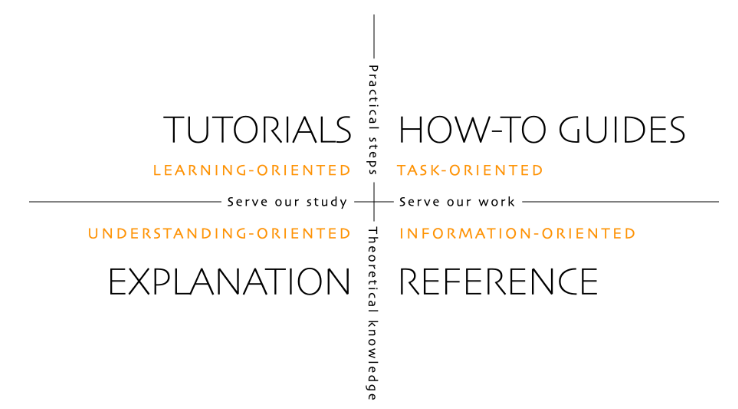Quarkus documentation content types
Quarkus documentation is structured into four distinct content types: concepts, how-tos, tutorials, and references. The composition and structure of Quarkus docs follow the Diátaxis systematic documentation framework for technical documentation authoring. Each content type resolves a different user need, fulfills a different purpose, and requires a different approach to its creation.
Diátaxis documentation framework
We chose to align Quarkus docs with the Diátaxis documentation framework[1], which defines a core content structure that addresses the different needs users have when consulting docs.

Image credit: https://diataxis.fr/
What follows is a brief summary of the different document types, but their site is worth a read if you want to understand more of the reasoning behind this classification.
Concept guides (Explanation)
Explanation is discussion that clarifies and illuminates a particular topic. Explanation is understanding-oriented.
Good concept guides:
-
focus on explaining a topic. Their goal is to help the reader understand the concept.
-
do not teach, instruct or include reference information. If you need to refer to a tutorial, how-to, or reference guide, point the reader to where they can find it, but do not replicate that information directly in your concept guide.
-
provide background information and context to explain why things work the way they do, or why they are built the way they are. You can cite design decisions, historical reasons, and technical constraints to reaffirm your points.
-
include specific examples to illustrate the explanation, but avoid making the explanation itself overly dependent on a specific technology or pattern of implementation.
-
analyze the concept from multiple perspectives and draw comparisons with alternative concepts discuss if it is relevant and useful for the reader’s understanding.
-
may express opinions about advantages and drawbacks of the concept that you are explaining relative to different potential use cases or applications.
How-to guides
How-to guides are directions that take the reader through the steps required to solve a real-world problem. How-to guides are goal-oriented.
Good how-to guides:
-
guide (walk-through) or demonstrate how to complete a task.
-
assume you have enough context to begin the task.
-
describes the concrete steps necessary to complete a task, but these steps could be in the middle of a larger task.
-
do not explain concepts, they rely on other documents (like concepts) to do that.
-
are adaptable to real-world use cases.
-
are practical (rather than complete).
Reference guides
Reference guides are technical descriptions of the machinery and how to operate it. Reference material is information-oriented.
Good reference guides:
-
are concise and to the point. They state, describe, and inform.
-
are consistent (to the extent possible) with other reference guides. Following the template helps here.
-
remain focused on describing their topic. They don’t explain or provide additional context from other sources.
-
provide examples or illustrations that help readers understand what is being described.
-
are kept up to date. While configuration reference material is generated, extension references that describe how configuration should be applied must be accurate to be useful.
Tutorials
Tutorials are lessons that take the reader by the hand through a series of steps to complete a project of some kind. Tutorials are learning-oriented.
Good tutorials:
-
provide a learning experience, giving the reader something they can do.
-
get the reader started (they do not create an expert).
-
provide the reader with concrete steps to follow that each have a comprehensible result.
-
are reliable and consistent (they work for all users, every time).
-
include only enough information to complete the task. They delegate to other documentation types (concepts or reference) to provide additional context.
-
focus on one way of doing the task. Alternative approaches are explored in other document types (a how-to guide, for example).
